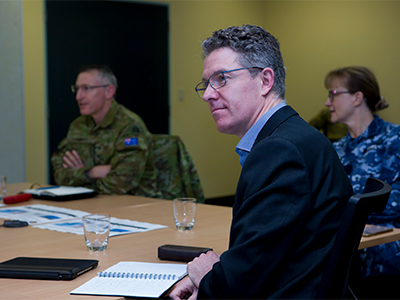Defence scientists investigating flexible work arrangements

Flexible work practices can increase the productivity and well-being of employees and maximise participation in the workforce. That’s what Defence is banking on by encouraging all staff to consider the options available. The official policy is ‘if you’re not working flexibly, why not?’.
Dr Melanie Farrier joined DSTG this year with responsibility for gender equity including managing the implementation of our Science in Australia Gender Equity (SAGE) program. Dr Farrier says flexible work arrangements are about creating an environment that assists employees to balance their work and home lives through agreed ways of structuring hours of work to enable operational outcomes to be achieved while providing flexibility that supports work/life balance objectives.
“The take-up of flexible work practices is particularly low among our male colleagues,” she points out. “We’re hoping that by sharing more case studies we’ll inspire an increase, with flow-on benefits to individuals, teams and our organisation.”
Going loudly beyond 9-5
Defence scientist Dr Justin Fidock accesses two main types of flexible arrangements. Well before the pandemic struck he had been working remotely for part of each week. During the pandemic the majority of his working has been from the home office.
“In addition, before the crisis I was arriving after school drop-off and occasionally leaving early, and doing that “loudly”,” says Dr Fidock. “So I make a point of not necessarily apologising for being late if a meeting is held before 9 am. I simply state that I have particular family responsibilities in the morning. In that way I have been communicating to my colleagues that I, too, draw on flexibility at DSTG to support work/life balance and strongly encourage my team to do the same.”
The other way that Justin supports flexible arrangements at DSTG is by being up front about how meetings are planned so that the time, date and frequency is based on the availability of all staff.
While the main model of flexible arrangements he sees in place are the common ones available to all of us, a different example is found in a colleague and his partner who have a preschool-aged child. Until recently the couple have shared that caring role. As a result they’re operating a lot more flexibly than normal to make up the core hours they’re required to perform. “That means he’s been sending me emails and doing work at times he normally wouldn’t, in order to fulfil obligations. That’s a good example of making it work, within constraints.”
The double-edged sword of working from home
As the pandemic hit, Dr Fidock sat down with his team to decide how they would communicate. “It’s actually easier now for people to reach me than before,” he concedes. “That’s the nature of working flexibly. It’s a double-edged sword that we’re all grappling with it at the moment.
“You can easily fall into the trap of responding to the latest digital communique. The technique I use to manage that reflex is to avoid checking my various work channels on the weekend, and trying not to do too much of that in the evenings either. I’m really mindful that if I’m sending an email at 9 pm, and telling my staff not to send emails after hours, it is sending mixed messages.”
He is keen to do the weight of his communications during normal business hours, though he admits it is a challenge. “There’s a bit of “creep” happening; I’d say that most of us are working slightly longer hours now than before the pandemic. There are many solutions, I’ve just been promoting the need to keep work/life balance in the foreground.”
Approaching difficult discussions
With regards to broaching flexible work arrangements with supervisors, Justin recommends in the first instance having a conversation about what it means to both supervisor and staff member. “There’s likely to be some education required, potentially for both parties,” he says. “A lot of supervisors may not be aware that “If not, why not?” is the default Defence policy position on flexible work. On the other hand, staff members may not understand the mutual obligations that come with flexible work arrangements.
“There’s a role for both parties to explain what flexibility means for them, and then getting into the nitty gritty of what it might look like. Unequivocally, the pandemic has been a silver lining for the push for wider adoption of flexible work practices.”
Some senior leaders are having their first experience of working from home, finding out firsthand what it means to work remotely as part of core business. “As a result they have a greater capacity to empathise with those in their workforce who choose or are forced to work flexibly,” says Dr Fidock. “This can only be a positive thing in terms of conversations moving forward about how we sustain the best aspects of this flexibility.”
DSTG has undertaken significant work over several years to improve gender equity, and earlier this year received the Athena Scientific Women’s Academic Network (SWAN) Institutional Bronze Award. The award acknowledges institutional commitment to advancing the careers of women in science, technology, engineering, mathematics (STEM) and medicine in higher education and research.

